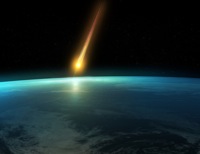Meteor
Etymology
Middle English metheour, from Middle French meteore, from Medieval Latin meteorum, from Greek meteōron, from neuter of meteōros high in air, from meta- + -eōros, from aeirein to lift
- Date: 15th century
Definitions
- 1 : an atmospheric phenomenon (as lightning or a snowfall)
- 2 a : any of the small particles of matter in the solar system that are directly observable only by their incandescence from frictional heating on entry into the atmosphere
- b : the streak of light produced by the passage of a meteor
Description
A meteor is the visible streak of light that occurs when a meteoroid, a sand- to boulder-sized particle of debris in the Solar System, enters the Earth's atmosphere. Meteors typically occur in the mesosphere, and most range in altitude from 75 km to 100 km. Millions of meteors occur in the Earth's atmosphere every day. Most meteoroids that cause meteors are about the size of a pebble. They become visible between about 40 and 75 miles (65 and 120 kilometers) above the earth. They disintegrate at altitudes of 30 to 60 miles (50 to 95 kilometers). Meteors have roughly a fifty percent chance of a daylight (or near daylight) collision with the Earth as the Earth orbits in the direction of roughly west at noon. Most meteors are, however, observed at night as low light conditions allow fainter meteors to be observed.
For bodies with a size scale larger than the atmospheric mean free path (10 cm to several metres) the visibility is due to the atmospheric ram pressure (not friction) that heats the meteoroid so that it glows and creates a shining trail of gases and melted meteoroid particles. The gases include vaporized meteoroid material and atmospheric gases that heat up when the meteoroid passes through the atmosphere. Most meteors glow for about a second. A relatively small percentage of meteoroids hit the Earth's atmosphere and then pass out again: these are termed Earth-grazing fireballs.
Meteors may occur in showers, which arise when the Earth passes through a trail of debris left by a comet, or as "random" or "sporadic" meteors, not associated with a specific single cause. A number of specific meteors have been observed, largely by members of the public and largely by accident, but with enough detail that orbits of the incoming meteors or meteorites have been calculated. All of them came from orbits from the vicinity of the asteroid belt.[1]
